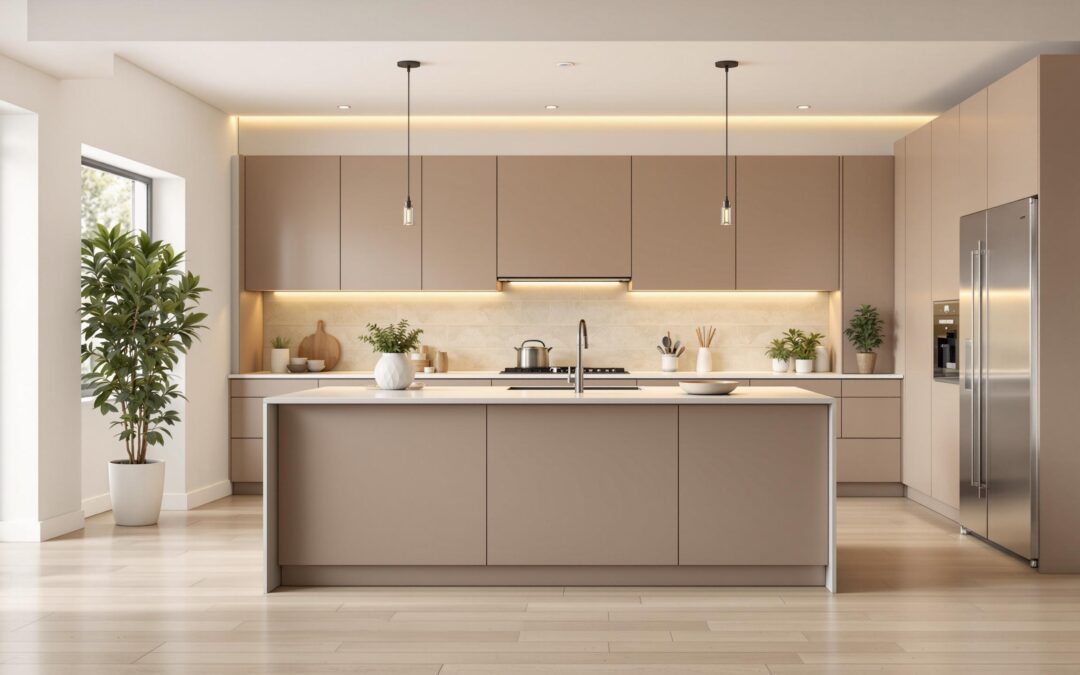Open-plan kitchens are stylish and practical, but they can be noisy. Sound bounces off hard surfaces like tiles and granite, appliances hum loudly, and social activities add to the chaos. Here’s how to fix it:
- Identify Noise Sources: Spot the loud appliances, reflective surfaces, and areas where sound escapes.
- Rearrange Your Layout: Position noisy appliances wisely, create zones, and use barriers like cabinets or partitions.
- Use Soundproof Materials: Install double-glazed windows, solid-core doors, and seal gaps to block sound.
- Add Soft Furnishings: Rugs, curtains, and upholstered furniture absorb noise and reduce echoes.
- Pick Quiet Appliances: Choose low-noise models and maintain them properly.
These steps can transform your open-plan kitchen into a quieter, more comfortable space. Keep reading for detailed tips and solutions.
6 Tips For Noise Control in Open Home Floor Plans by Audimute

Step 1: Find Noise Sources and Problem Spots
To tackle kitchen noise effectively, start by identifying where the noise comes from and how it spreads. Pinpointing these areas helps you focus on the right solutions.
Common Kitchen Noise Sources
Make a list of the main culprits in your kitchen:
- Appliances like refrigerators, dishwashers, and microwaves
- Extractor fans and other ventilation systems
- Loud gadgets such as food processors, coffee grinders, and blenders
- Clattering from utensils, chopping, and other impact sounds
- Plumbing systems and waste disposal units
Pay attention to when these noises occur and how long they last to decide what needs attention first.
Track How Sound Travels
In open-plan spaces, sound moves in predictable ways. Trace the paths it takes and how surfaces amplify or leak noise.
Hard Surfaces That Reflect Noise
Some materials make noise worse by bouncing sound around. Look for:
- Tiled splashbacks
- Glass windows and doors
- Stone or ceramic flooring
- Metal surfaces on appliances
- Granite or marble worktops
Areas Where Sound Escapes
Sound can leak through small gaps and openings. Check for:
- Gaps around windows and doors
- Electrical sockets and light fixtures
- Ventilation ducts or air returns
- Spaces between walls and appliances
- Unsealed joints between different flooring materials
Impact of Room Layout
The way your kitchen is arranged can affect how sound behaves. Consider:
- Open archways or doorways that let sound travel freely
- High ceilings or exposed beams that amplify echoes
- Placement of noisy appliances
- The distance between cooking and dining areas
Observe how noise changes throughout the day to prioritise which areas need soundproofing first.
Step 2: Plan Kitchen Layout for Noise Control
After identifying noise sources, focus on reorganising your kitchen layout to disrupt sound flow. Thoughtful positioning of key elements can help limit noise transmission effectively.
Position Noisy Appliances Strategically
Create specific zones for appliances to help contain sound:
- Place dishwashers and washing machines against solid walls instead of partition walls.
- Keep refrigerators away from dining or living areas, surrounding them with cabinetry for extra sound insulation.
- Position countertop appliances like blenders and food processors in corners where two walls meet.
- If possible, include a butler’s pantry or utility room to house louder equipment.
Use Barriers to Reduce Noise
Incorporate physical barriers – either permanent or temporary – to block sound:
- Install floor-to-ceiling cabinets to separate cooking and living areas.
- Opt for kitchen islands with solid bases instead of open shelving.
- Use partial-height glass partitions to reduce noise while maintaining a visual connection.
- Add movable screens or dividers to adapt the space as needed.
Create Functional Activity Zones
Organise your kitchen into zones designed to manage noise more effectively:
Cooking Zone
Keep the cooking area away from social spaces:
- Use sound-dampening worktops in the prep area to reduce movement noise.
- Position cooking appliances near solid structures for better noise absorption.
- Install cabinet doors with soft-close mechanisms to minimise slamming sounds.
Dining and Social Areas
Design these spaces to naturally absorb sound:
- Position dining areas away from noisy appliances.
- Create a buffer between cooking and dining zones.
- Use upholstered seating to help absorb sound.
- Add storage units that also act as sound barriers.
Traffic Flow
Plan movement patterns to keep noise levels low:
- Ensure walkways are at least 1 metre wide to reduce congestion and noise.
- Place frequently used items in areas that don’t disrupt quiet zones.
- Design storage solutions to minimise unnecessary movement.
The next step involves selecting materials and décor that further reduce noise levels.
Step 3: Add Sound-Blocking Materials
Focus on windows and doors – common entry points for noise – to reduce sound intrusion. With your layout ready, it’s time to choose materials that help block unwanted noise.
Upgrade Windows and Doors
Windows and doors play a big role in minimising noise in an open-plan kitchen.
For Windows:
- Switch to double-glazed windows with different glass thicknesses to break up sound waves.
- Add secondary glazing with a 100 mm gap between panes for extra soundproofing.
- Use acoustic laminated glass to reduce noise even further.
- Seal window frames with acoustic sealants and flexible strips for a tight fit.
For Doors:
- Install solid-core doors that are better at blocking sound.
- Add automatic door bottoms to ensure a snug closure.
- Seal door edges and frames thoroughly.
- In utility areas, consider double doors to create an airlock effect.
Seal Sound Leaks
To deal with sound leaks discovered earlier, try these solutions:
- Attach draft excluders under doors.
- Use sealing systems around door and window frames for complete coverage.
sbb-itb-06ab728
Step 4: Use Soft Items to Improve Sound Quality
In addition to making structural changes, incorporating soft furnishings can help reduce unwanted noise in an open-plan kitchen.
Introduce Rugs and Upholstered Furniture
Items like rugs, curtains, and cushioned furniture can significantly reduce sound waves. Place rugs in high-traffic areas and opt for upholstered chairs or benches in dining spaces to minimise noise.
Include Sound-Absorbing Decorations
Decorative pieces designed to absorb sound, such as acoustic panels or textured wall hangings, can help cut down on echoes and make the room feel more peaceful. These additions not only improve sound but also enhance the overall look of the space.
Step 5: Pick Quieter Appliances
Reducing noise in open-plan kitchens starts with choosing quieter appliances. Many modern options come with sound-reduction features, making your cooking space more peaceful.
Choose Low-Noise Appliances
When shopping for kitchen appliances, look for models designed to operate quietly:
- Check the manufacturer’s noise ratings.
- Opt for models with inverter systems or brushless motors.
- Pick appliances with multiple speed settings for quieter use.
- Use anti-vibration mounts to reduce sound transfer.
Minimise Appliance Noise
You can take extra steps to make your appliances even quieter:
Cabinet Insulation
- Line cabinet interiors with sound-absorbing materials.
- Place rubber mats beneath appliances.
- Install soft-close hinges and drawer mechanisms.
Smart Placement
- Keep noisier appliances away from living and dining areas.
- Position heavy-duty machines along walls that aren’t shared with other rooms.
- Use dedicated housings made with sound-dampening materials.
Regular Maintenance
- Tighten any loose parts.
- Lubricate moving components.
- Replace worn seals or gaskets.
- Ensure appliances are level to prevent vibrations.
Check out the next section for more ways to cut down on kitchen noise.
Step 6: Extra Noise-Cutting Methods
In addition to selecting quieter appliances, you can reduce noise further by sealing gaps and using natural sound absorbers. These steps help tackle any leftover noise that your layout and materials might not fully address.
Fix Sound Leaks
Small gaps can let in a surprising amount of noise. Here’s how to seal the most common trouble spots:
Electrical Outlets and Switches
- Use acoustic putty pads behind outlet boxes.
- Add foam gaskets under outlet and switch covers.
- Fill wiring gaps with acoustic sealant.
Windows and Doors
- Apply weatherstripping around window and door frames.
- Install door sweeps to block gaps at the bottom.
- Upgrade existing glazing seals for better noise reduction.
Plumbing and Ductwork
- Wrap pipes with acoustic lagging to minimise vibrations.
- Seal gaps around pipe penetrations.
- Use flexible duct connectors to reduce noise transmission.
- Add acoustic grilles to ventilation openings.
Wall Junctions
- Seal wall junctions with acoustic sealant.
- Fill gaps between skirting boards and flooring.
- Close up corner intersections to block sound leaks.
Once you’ve sealed these structural gaps, you can use natural methods to absorb any lingering noise.
Use Plants for Sound Control
Plants are a natural way to reduce noise and can complement your structural fixes.
Where to Place Plants
- Put large plants in corners where sound tends to reflect.
- Arrange green barriers near noisy appliances.
- Use hanging plants to soften sound bouncing off ceilings.
- Place plants on windowsills to help block external noise.
Great Plant Choices
- Peace lilies
- Snake plants
- Rubber plants
- Ficus trees
Keeping Plants Effective
- Keep plants healthy and free of dust to improve their sound-absorbing abilities.
- Choose species that thrive in your kitchen’s lighting and temperature conditions.
Get Expert Help from Sound of Silence

Dealing with noise issues in open-plan kitchens can be tricky. That’s where Sound of Silence comes in. By pinpointing noise sources and weak spots, their team creates customised solutions that blend seamlessly with your kitchen’s design.
Thorough Assessments
Their acoustic consultants carefully evaluate:
- Noise frequencies causing disruption
- How sound travels through your space
- Weak areas in your kitchen’s structure
- The best places to apply acoustic materials
Tailored Soundproofing Plans
Sound of Silence crafts bespoke solutions, including:
- Testing appliance vibrations to minimise noise
- Analysing materials for maximum effectiveness
- Applying specific acoustic treatments where needed
- Using sound masking to separate different zones
Expert Installation
Their team ensures every step is handled professionally:
- Installing acoustic materials with precision
- Integrating solutions into your existing layout
- Sealing gaps where sound could escape
- Testing everything to confirm it works perfectly
Support After Installation
Even after the job is done, they’ve got you covered with:
- Acoustic performance checks
- Tips for maintaining your soundproofing
- Advice on further noise reduction
- Ongoing support whenever needed
With Sound of Silence, you get more than just noise reduction – you get a kitchen that’s both functional and peaceful, without compromising on style.
Steps to a Quieter Kitchen
Creating a peaceful open-plan kitchen requires a thoughtful approach to managing noise. The key steps include identifying noise sources, planning the layout, choosing the right materials, and upgrading to quieter appliances.
Start by pinpointing where the noise comes from and consider relocating loud appliances. Use soundproofing techniques, such as adding soft furnishings, which not only reduce noise but also enhance the room’s look. When shopping for appliances, opt for newer models designed to run quietly.
For a more tailored solution, consulting professionals like Sound of Silence can help fine-tune your noise-reduction plan. Whether you’re designing a brand-new kitchen or improving an existing one, combining soundproofing methods with low-noise appliances can transform your space into a calm and enjoyable environment.

